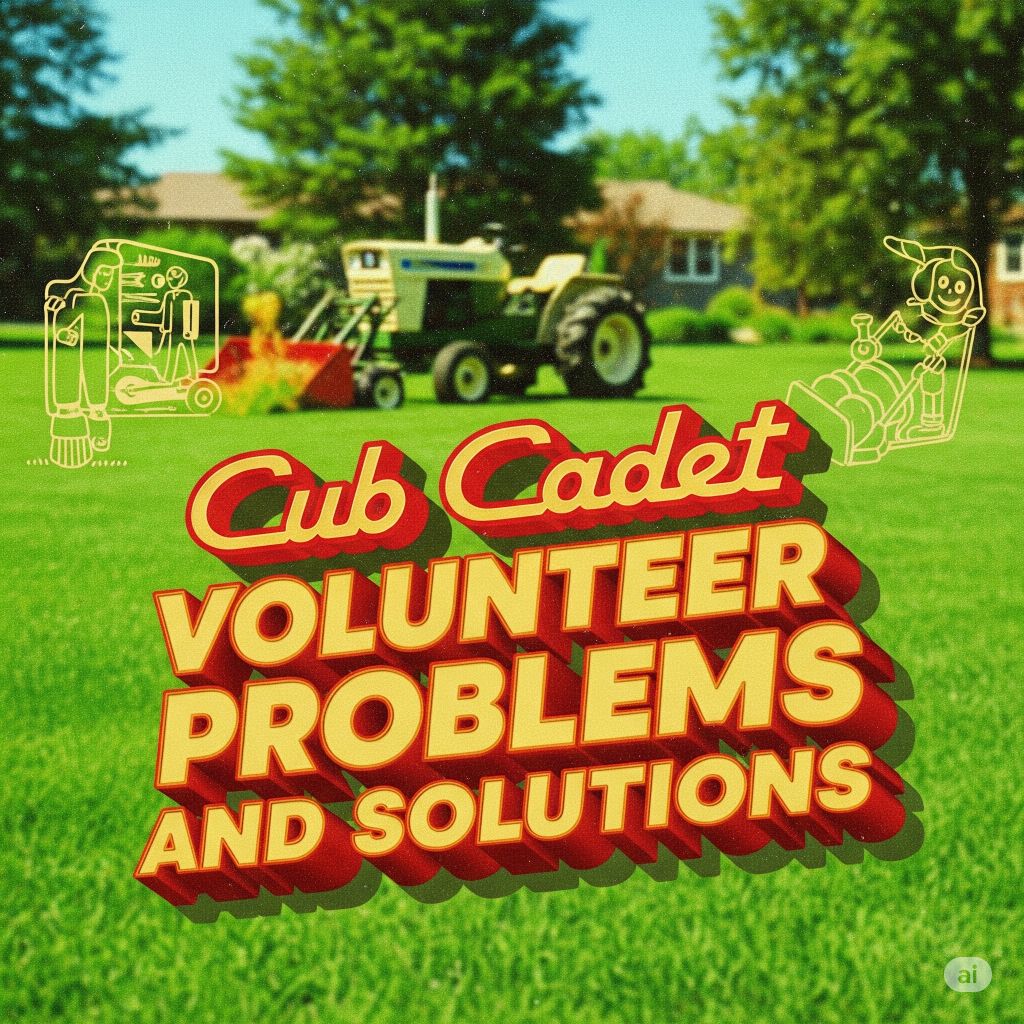
The Cub Cadet Volunteer UTV was launched as a robust side-by-side utility vehicle, featuring gasoline, diesel, and EFI versions, 2WD or 4WD, and up to 1,400 lbs of payload capacity. Despite sturdy design, owners have reported a range of mechanical and electrical issues over the years.
Common Use Cases:
- Farm and ranch work
- Light construction
- Outdoor recreation/hunting
- Grounds and trail maintenance
2. Engine and Starting Problems
2.1. Hard Starting or No Start
Common Causes:
- Weak or dead battery
- Dirty or corroded battery terminals
- Faulty ignition switch or starter relay
- Fuel delivery issues (clogged fuel filter, bad pump, dirty carburetor or injector)
- Choke or cold-start circuit malfunction (carb models)
Solutions:
- Ensure the battery is fully charged and holds a charge (>12.6V). Replace if not.
- Clean all terminal connections and battery posts. Use a wire brush and apply dielectric grease.
- Test ignition switch/solenoid with a multimeter and replace if needed.
- Replace old fuel, clean or replace the filter, and inspect/replace the fuel pump.
- If equipped with a carburetor, clean jets and check for choke operation.
2.2. Engine Runs Rough, Misfires, or Stalls
Possible Causes:
- Clogged air filter
- Old/contaminated fuel
- Fouled spark plug or bad plug wire
- Vacuum leak at intake manifold
- Dirty or gummed-up carburetor
Solutions:
- Replace/clean air filter as per schedule—more often if in dusty environments
- Use fresh, ethanol-free gasoline when possible; drain old fuel
- Replace spark plug(s), gap to spec, and inspect/coReplace wires
- Check intake manifold and vacuum lines for cracks/leaks
- Remove carburetor, clean thoroughly, and check float bowl/gaskets
2.3. Overheating
Common Causes:
- Low coolant level or leaks
- Radiator clogged with debris (grass, mud, etc.)
- Faulty thermostat
- Inoperative cooling fan (relay, sensor, or fan motor failure)
- Water pump failure
Solutions:
- Check and top off coolant using the right mix
- Flush radiator and clear debris using compressed air or water spray (from the engine side out)
- Replace faulty thermostat
- Test cooling fan relay, sensor, and operation—replace failed components
- Check for signs of water pump leaks or failure; replace as necessary
3. Transmission and Drivetrain Issues
3.1. Difficult Shifting or Won’t Go Into Gear
Possible Causes:
- Stretched or misadjusted shift linkage
- Low or dirty transmission fluid
- Internal gearbox wear/damage
- Clutch issues (manual models)
Solutions:
- Adjust or lubricate the shift linkage according to service manual
- Change transmission fluid and use only recommended spec
- Internal repairs require professional help
- Inspect clutch cable (if so equipped) and clutch engagement; replace as needed
3.2. 4WD/2WD Not Engaging
Possible Causes:
- Broken or jammed 4WD actuator
- Faulty 4WD switch/electrical connections
- Damaged drive shaft or CV joints
Solutions:
- Test/replace the 4WD actuator or switch
- Clean connectors and wiring
- Inspect and replace damaged or worn-drive components
4. Electrical and Charging Problems
4.1. Battery Always Dead or Doesn’t Hold Charge
Causes:
- Parasitic drain from accessories or corroded wiring
- Short rides preventing full recharge
- Failing stator or voltage regulator
Solutions:
- Disconnect accessories when not in use; use a multimeter to check for draws with ignition off
- Use a battery maintainer when storing vehicle
- Check charging voltage (should be 13.8–14.5V); replace stator or regulator if below spec
4.2. Lights or Dash Not Working
Causes:
- Blown fuses, poor ground, or corroded connectors
- Chafed wires, especially under dash or seat
Solutions:
- Replace fuses/make sure to use correct amperage
- Inspect and clean all ground points
- Repair or replace damaged sections of wiring harness
5. Fuel System Problems
5.1. Fuel Pump Failure
Reported often around 400+ hours
Symptoms:
- No start, engine sputters or dies after starting
Solutions:
- Confirm no fuel at carb/injector when cranking; replace pump with updated OEM or reliable aftermarket unit
- Check fuel lines for obstructions/leaks
5.2. Fuel Leaks
Causes:
- Cracked fuel lines or deteriorated O-rings at connections
- Faulty fuel tank cap, bad vent
Solutions:
- Replace all worn/cracked lines and seals
- Use only ethanol-safe hose
- Replace poor-fitting or damaged gas cap
6. Suspension and Steering Issues
6.1. Loose or Wobbly Steering
Causes:
- Worn tie rod ends, ball joints, or bushings
- Loose steering rack mounts
Solutions:
- Inspect and replace worn components as needed
- Tighten mounts and lubricate pivot points
6.2. Suspension Noise
Common Causes:
- Dry or worn suspension bushings
- Damaged shocks
Solutions:
- Grease all suspension bushings regularly
- Replace shocks if leaking or with poor rebound
7. Brake Problems
7.1. Weak or Squealing Brakes
Causes:
- Worn brake pads or shoes
- Dirty or glazed rotors/drums
- Air in hydraulic brake lines (for disc setups)
Solutions:
- Replace worn pads/shoes; clean or replace rotors/drums
- Bleed brakes to remove any air
- Regularly flush brake fluid as per manual
8. Miscellaneous and Body Issues
8.1. Doors, Bed, or Latch Problems
- Lubricate all latches, check for bent hardware
- Replace springs or worn latch components as necessary
8.2. Rattles and Squeaks
- Tighten all panels, mounts, and plastic fasteners
- Use foam/rubber between body panels and frame to dampen noise
9. Recalls and Service Bulletins
- Several service bulletins exist for fuel lines, brake system updates, and electrical gremlins
- Always check with your dealer (or NHTSA database in the US) for recalls by VIN
10. Owner Maintenance Checklist
- Change engine oil and filter every 50 hours or annually
- Check and replace air filter frequently
- Lubricate all pivot points (steering, suspension, bed) regularly
- Inspect/adjust brakes and fluid levels every 100 hours
- Test battery and charging system seasonally
11. When To Seek Professional Help
- Internal engine or transmission repair
- Complicated wiring/electrical diagnostics
- Severe frame or drivetrain issues
12. Summary Table
| Problem | Common Cause | Solution |
|---|---|---|
| No Start | Battery, ignition, starter | Check/replace, clean terminals |
| Rough Running | Air, fuel, spark | Replace filter, spark, clean carb |
| Overheating | Radiator/coolant/fans | Flush, replace/compress debris |
| Hard Shifting | Linkage, fluid, clutch | Adjust, replace fluid, inspect |
| Dead Battery | Parasitic drain, stator | Test draw, replace regulator |
| Fuel issues | Pump, lines, filter | Replace pump/lines, use new filter |
| Weak Brakes | Worn pads, air in lines | Replace pads, bleed brakes |
| Loose Steering | Ball joints, bushings | Replace worn parts, lubricate |
13. Frequently Asked Questions
Q: My Volunteer sputters when accelerating. What’s the fix?
A: Usually dirty injectors/carburetor or bad fuel. Clean the fuel system, replace old gas, and check filters.
Q: What’s the right battery size?
A: Typically a Group U1 AGM or standard garden tractor battery.
Q: Can I use regular automotive oil?
A: Use the manufacturer’s recommended oil weight and specs (often 10W-30 or 5W-30)—automotive oil can cause clutch slippage in wet clutches.
14. Conclusion
The Cub Cadet Volunteer is a hardworking, reliable UTV when regular maintenance is performed and issues are caught early. Battery, fuel delivery, and electrical issues tend to be most common, but all are manageable with basic tools and attention. For anything beyond basic troubleshooting, a qualified dealer can ensure safety and long-term machine life.
Want troubleshooting flowcharts, wiring diagrams, or a maintenance checklist PDF? Let me know, and I can generate custom diagrams for your needs!

I’m David man behind Lawn Mowerly; I’ve been dealing with lawnmowers and Tractors with my father since I was a kid. I know every make and model and what each one is capable of and love helping people find the perfect equipment for their needs.
